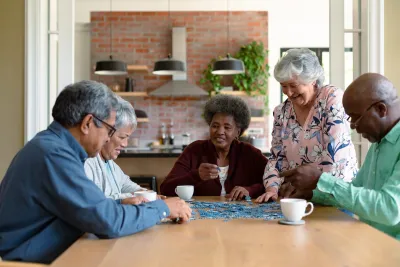Designing for the unique needs of elderly people can help them maintain social connections and mental acuity.

Aging — that of ourselves or of our loved ones — can be a painful subject. Too often, elderly people and their families fear the prospect of moving their older relatives to a senior living facility, worried that it will sever their social connections and accelerate their mental degradation.
But as Michelle Gagnon-Creeley writes in an article for Happy Cities, it doesn’t have to be this way. Designing buildings and communities with older people in mind can support their independence while offering a sense of safety and community.
“Socially connected neighbours are healthier, more resilient, and often able to stay longer in their home and community as they age. The design of our homes can help foster these connections,” Gagnon-Creeley adds. The article summarizes findings from a Happy Cities study that analyzed 20 senior housing buildings in British Columbia, evaluating how they each foster connection and community.
The article outlines four key strategies for designing age-friendly homes: “social homes” that offer opportunities for interaction and accommodate changing mobility needs; “social circulation” that transforms transitional spaces like stairwells and hallways into comfortable, social spaces; “social amenities” that offer activities for stimulation and gathering; and “social building edges,” the transition zones between public and private spaces that can be elevated to provide a visual connection to the street and outdoor recreation areas.
FULL STORY: What makes an age-friendly home?

Alabama: Trump Terminates Settlements for Black Communities Harmed By Raw Sewage
Trump deemed the landmark civil rights agreement “illegal DEI and environmental justice policy.”

Study: Maui’s Plan to Convert Vacation Rentals to Long-Term Housing Could Cause Nearly $1 Billion Economic Loss
The plan would reduce visitor accommodation by 25% resulting in 1,900 jobs lost.

Planetizen Federal Action Tracker
A weekly monitor of how Trump’s orders and actions are impacting planners and planning in America.

Wind Energy on the Rise Despite Federal Policy Reversal
The Trump administration is revoking federal support for renewable energy, but demand for new projects continues unabated.

Passengers Flock to Caltrain After Electrification
The new electric trains are running faster and more reliably, leading to strong ridership growth on the Bay Area rail system.

Texas Churches Rally Behind ‘Yes in God’s Back Yard’ Legislation
Religious leaders want the state to reduce zoning regulations to streamline leasing church-owned land to housing developers.
Urban Design for Planners 1: Software Tools
This six-course series explores essential urban design concepts using open source software and equips planners with the tools they need to participate fully in the urban design process.
Planning for Universal Design
Learn the tools for implementing Universal Design in planning regulations.
Caltrans
Smith Gee Studio
Institute for Housing and Urban Development Studies (IHS)
City of Grandview
Harvard GSD Executive Education
Toledo-Lucas County Plan Commissions
Salt Lake City
NYU Wagner Graduate School of Public Service





























